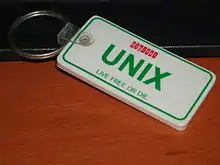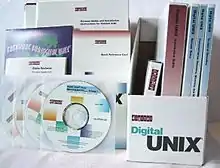Tru64 UNIX
Tru64 UNIX is a discontinued 64-bit UNIX operating system for the Alpha instruction set architecture (ISA), currently owned by Hewlett-Packard (HP). Previously, Tru64 UNIX was a product of Compaq, and before that, Digital Equipment Corporation (DEC), where it was known as Digital UNIX (originally DEC OSF/1 AXP).
 | |
| Developer | DEC, HP, IBM, Compaq |
|---|---|
| OS family | Unix |
| Working state | Retired (supported until December 2012)[1] |
| Source model | Closed source |
| Initial release | January 1992 |
| Latest release | 5.1B-6 / October 1, 2010 |
| Platforms | DEC Alpha |
| Kernel type | Hybrid kernel |
| Default user interface | Command-line interface |
| License | Proprietary |
| Official website | Tru64 UNIX Software |
As its original name suggests, Tru64 UNIX is based on the OSF/1 operating system. DEC's previous UNIX product was known as Ultrix and was based on BSD.
It is unusual among commercial UNIX implementations, as it is built on top of the Mach kernel developed at Carnegie Mellon University. (Other UNIX and UNIX-like implementations built on top of the Mach kernel are GNU Hurd, NeXTSTEP, MkLinux, macOS and Apple iOS.)
Tru64 UNIX required the SRM boot firmware found on Alpha-based computer systems.
DEC OSF/1 AXP
In 1988, Digital Equipment Corporation (DEC) joined with IBM, Hewlett-Packard, and others to form the Open Software Foundation (OSF). A primary aim was to develop a version of Unix, named OSF/1, to compete with System V Release 4 from AT&T Corporation and Sun Microsystems. After DEC's first release (OSF/1 Release 1.0) in January 1992 for their line of MIPS-based DECstation workstations,[2] DEC ported OSF/1 to their new Alpha AXP platform (as DEC OSF/1 AXP), and this was the first version (Release 1.2) of what is most commonly referred to as OSF/1. DEC OSF/1 AXP Release 1.2 was shipped on March 1993. OSF/1 AXP was a full 64-bit operating system and the native UNIX implementation for the Alpha architecture. After OSF/1 AXP V2.0 onwards, UNIX System V compatibility was also integrated into the system.
Digital UNIX


In 1995, starting with release 3.2, DEC renamed OSF/1 AXP to Digital UNIX to reflect its conformance with the X/Open Single UNIX Specification.[3]
Tru64 UNIX
After Compaq's purchase of DEC in early 1998, with the release of version 4.0F, Digital UNIX was renamed to Tru64 UNIX to emphasise its 64-bit-clean nature and de-emphasise the Digital brand.
In April 1999, Compaq announced that Tru64 UNIX 5.0 successfully ran on Intel's IA-64 simulator.[4] However, this port was cancelled a few months later.[5]
A Chinese version of Tru64 UNIX named COSIX was jointly developed by Compaq and China National Computer Software & Technology Service Corporation (CS&S).[6] It was released in 1999.
TruCluster Server
From release V5.0 Tru64 UNIX offered a clustering facility named TruCluster Server. TruCluster utilised a cluster-wide filesystem visible to each cluster member, plus member specific storage and an optional quorum disk. Member specific files paths were enhanced symbolic links incorporating the member id of the owning member. Each member had one or zero votes, which, combined with a possible quorum disk, implemented a cluster formation algorithm similar to that found in OpenVMS.
End of Life
With their purchase of Compaq in 2002, HP announced their intention to migrate many of Tru64 UNIX's more innovative features (including its AdvFS, TruCluster, and LSM) to HP-UX. In December 2004, HP announced a change of plan: they would instead use the Veritas File System and abandon the Tru64 advanced features. In the process, many of the remaining Tru64 developers were laid off.[7]
The last maintenance release, 5.1B-6 was released in October 2010.[8]
In October 2010, HP stated that they would continue to support Tru64 UNIX until 31 December 2012.[9]
In 2008, HP contributed the AdvFS filesystem to the open-source community.[10]
Versions
These versions were released for Alpha AXP platforms.[11][12][13][14]
| Version | Approx Date | Notes |
|---|---|---|
| DEC OSF/1 1.2 | March 1993 | |
| DEC OSF/1 1.2A | April 1993 | Hardware only release |
| DEC OSF/1 1.3 | July 1993 | |
| DEC OSF/1 1.3A | September 1993 | |
| DEC OSF/1 1.3B | November 1993 | Hardware only release |
| DEC OSF/1 2.0 | March 1994 | |
| DEC OSF/1 2.0A | April 1994 | Logical Storage Manager (LSM) v1; AdvFS v1; ASE v1 introduced |
| DEC OSF/1 2.0B | May 1994 | Hardware only release |
| DEC OSF/1 2.1 | July 1994 | |
| DEC OSF/1 3.0 | August 1994 | SMP support |
| DEC OSF/1 3.0A | September 1994 | ASE v1.1; System V Environment |
| DEC OSF/1 3.0B | September 1994 | Hardware only release |
| Digital UNIX 3.2 | February 1995 | |
| Digital UNIX 3.2A | March 1995 | ASE v1.2 |
| Digital UNIX 3.2B | May 1995 | Hardware only release |
| Digital UNIX 3.2C | July 1995 | |
| Digital UNIX 3.2D-1 | January 1996 | ASE v1.3 |
| Digital UNIX 3.2D-2 | January 1996 | Hardware only release |
| Digital UNIX 3.2E | March 1996 | TruCluster v1.0 |
| Digital UNIX 4.0 | March 1996 | CDE made default desktop |
| Digital UNIX 3.2F | June 1996 | |
| Digital UNIX 3.2G | August 1996 | |
| Digital UNIX 4.0A | September 1996 | ASE v1.4 |
| Digital UNIX 4.0B | December 1996 | X/Open-compliant Curses |
| Digital UNIX 4.0C | April 1997 | |
| Digital UNIX 4.0D | December 1997 | Y2K readiness; extended UIDs/GIDs; class scheduler; JDK 1.1.4; Netscape 3.04 |
| Digital UNIX 4.0E | November 1998 | ASE v1.5; USB support; AdvFS atomic write data logging; Sendmail 8.8.8; ODBC/JDBC; Netscape 4.05 |
| Tru64 UNIX 4.0F | April 1999 | USB keyboard/mouse support; limited DVD support; Netscape 4.5; COM for Tru64 UNIX |
| Tru64 UNIX 5.0 | July 1999 | Improved performance/scalability; Hot-swap; Sendmail 8.8.8; OpenMP; Netscape 4.51; X11R6.3 |
| Tru64 UNIX 5.0A | April 2000 | UFS Delayed metadata option; Sendmail 8.9.3; Netscape 4.7; ISO 9660 install disc |
| Tru64 UNIX 4.0G | May 2000 | Maximum 256 X clients (formerly 128); Netscape 4.7 |
| Tru64 UNIX 5.1 | September 2000 | Extended System V functionality; Tcl/Tk 8.2; IPv6 |
| Tru64 UNIX 5.1A | September 2001 | Online CPU addition/removal; UNIX 98 Conformance; X11R6.5; Netscape 4.76 |
| Tru64 UNIX 5.1B | September 2002 | Big Pages; IPv6 Enhancements; Netscape 6; Unicode 3.1 |
| Tru64 UNIX 5.1B-1 | November 2003 | Name Service Switch (NSS); Mozilla 1.4 |
| Tru64 UNIX 5.1B-2 | August 2004 | Unified Buffer Cache Scaling; Perl 5.8.4; Mozilla 1.6 |
| Tru64 UNIX 5.1B-3 | June 2005 | AdvFS robustness; Accounting refinements; LSM enhancements; Mozilla 1.7.5 |
| Tru64 UNIX 5.1B-4 | December 2006 | POSIX conformance; Rebranding (COMPAQ to HP); 2007 U.S. DST changes; BIND 9.2.5 |
| Tru64 UNIX 5.1B-5 | March 2009 | Standards conformance; Support for latest DST changes; BIND 9.2.8 |
| Tru64 UNIX 5.1B-6 | October 2010 | Defect fixes only. Support ended 31 Dec 2012 |
References
- Tru64 UNIX Support Roadmap
- Ellen Minter (1992-01-28). "Press Release — OSF/1". Newsgroup: bit.listserv.esl-l. Usenet: 9201282310.AA15415@enet-gw.pa.dec.com. Retrieved 2007-08-21.
- Steve Lionel (1995-04-17). "Re: OSF vs. Digital Unix". Newsgroup: comp.unix.osf.osf1. Usenet: 3mu6ho$jhs@jac.zko.dec.com. Retrieved 2007-08-21.
- "Compaq Tru64 UNIX Runs on Intel's Merced Simulator". 1999-04-08. Retrieved 2008-02-24.
- "Compaq kills Tru64 development on Intel's Merced". 1999-09-22. Archived from the original on 2007-12-20. Retrieved 2008-02-24.
- "China National Computer Software & Technology Service Corporation Chooses Compaq's Digital UNIX Technology as Basis for China's 64-Bit UNIX". INTERACTIVE BUSINESS NETWORK RESOURCE LIBRARY. 1998-09-10. Archived from the original on 2012-07-10. Retrieved 2011-09-26.
- Ashlee Vance (2004-12-02). "HP laughs off Tru64 promises, welcomes Veritas". The Register. Retrieved 2008-04-12.
- "Release Notes for Version 5.1B-6". November 2010. Retrieved 2010-11-16.
- "Tru64 Roadmap October 2010" (PDF). November 2010. Retrieved 2010-11-16.
- HP (2008-06-23). "HP Contributes Source Code to Open Source Community to Advance Adoption of Linux". HP. Retrieved 2008-06-23.
- Cheek, Matthew (1999). Digital UNIX System Administrator's Guide. ISBN 1-55558-199-4.
- "Tru64 UNIX Online Documentation and Reference Pages". Retrieved 2009-12-03.
- "DIGITAL UNIX Release Notes for Version 4.0B". Retrieved 2012-01-05.
- "DIGITAL UNIX Release Notes for Version 4.0E" (PDF). Archived from the original (PDF) on 2012-10-08. Retrieved 2009-12-03.
External links
| Wikimedia Commons has media related to Tru64. |
- Tru64 UNIX - HP's official Tru64 UNIX site
- Tru64 FAQ from UNIXguide.net
- comp.unix.tru64 - Newsgroup on running, owning and administering Tru64 UNIX (web-accessible via Google Groups)
- comp.unix.osf.osf1 - Newsgroup on running, owning and administering OSF/1 (web-accessible via Google Groups)
- HP Tru64 Unix man pages and shell accounts provided by Polarhome
